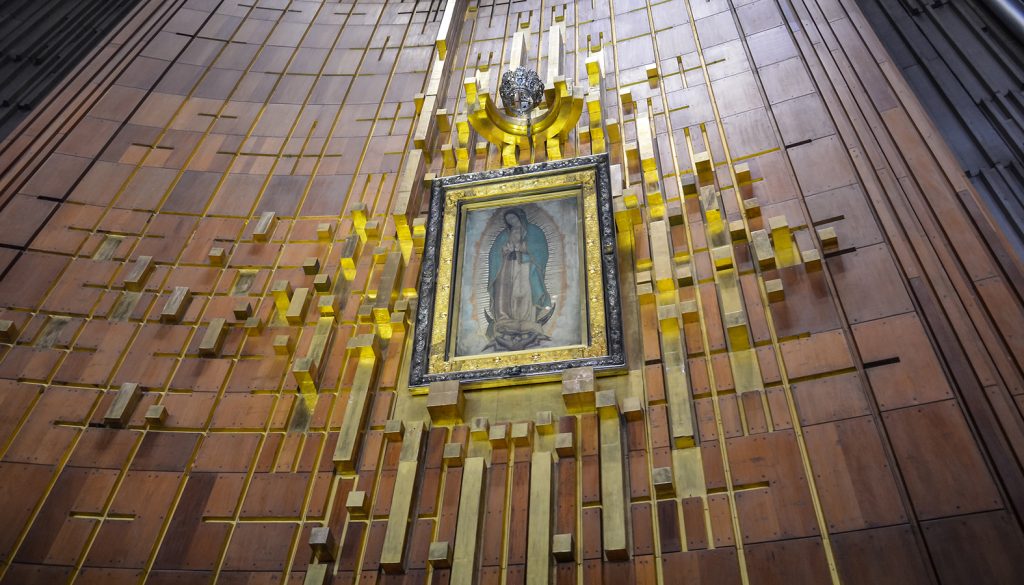This is not about my pilgrimage to Mexico, but it is about something I learned there about the miraculous tilma that rests high above the altar in the basilica of Our Lady of Guadalupe.
Most things I was told on this trip about that tilma I already knew. I even freshened up on my facts before leaving, in preparation for seeing a real miracle for the first time with my own eyes.
I thought I had all my ducks in a row: The tilma was made from cactus fibers, because that was the material available to poor indigenous people to keep the cold of December at bay. This same material should have disintegrated in 50-70 years, yet there it hangs over the altar, fully intact 491 years later.
But I was so gobsmacked to learn that elements of the tilma are in fact deteriorating that I found myself compelled to use the word gobsmacked.
I want so sincerely to believe that what I saw in that frame above the altar was in fact a miraculous image produced by a divine hand. I have the same inclination toward the Shroud of Turin, and the more I read, and the more exact the science becomes, the more the Shroud’s genuineness seems real.
I do not know if the tilma has undergone such scientific scrutiny — and I also realize the Church does not require us to believe in any “approved” apparition — but Our Lady of Guadalupe does possess a lot of other bona fides toward authenticity. The constellations of the stars oriented just as they would have been on Dec. 12, 1531, the Aztec imagery blended with the Christian message of the theotokos, flowers found only in Spain and never in December anywhere.
So, what was wrong and what was deteriorating?
The thing I learned about the tilma was that not long after St. Juan Diego revealed the image to his bishop, someone in authority within the Church decided the image needed more bling and so this remarkable fabric was “augmented” with some gold leaf painting. It is the gold leaf — the obvious work of man — that is now breaking down and flaking off the tilma.
What were they thinking? It only took a minute, and I knew. It is the way we are built, at least since the time of the fall. Think of all the cellphone photos someone has taken of the sunset over the Grand Canyon or some other God-given wonder. That photo then goes through myriad photo apps and filters so the person who has taken the photo has put their stamp on it. Why can’t someone stare in wonder and gratitude at the Grand Canyon and leave the phone in their pocket? The short answer is: We just cannot help ourselves.
The people of Babel were the descendants of Noah’s son Shem. God had seen their ancestors through the flood and brought them to a land where they built a prosperous city — but it was not enough. It was the first “build back better” municipal project, and the citizens of Babel believed they were going to be famous for their efforts. They were, but not for the reasons they hoped.
Even the apostles who witnessed the Transfiguration seem to fall into this trap. After seeing Jesus’ face shine like the sun and Moses and Elijah make an appearance, the first thing St. Peter thinks he needs to do is build three booths. Scripture tells us he kept on talking, maybe he was spitballing whether they would sell annual passes to the site, when God the Father personally intervened, bringing St. Peter and the other apostles present first to their senses, and then, to their knees.
The excellent Catholic thinker Peter Kreeft, Ph.D., once remarked the world’s oldest profession was not what people have thought it was. The first and oldest profession was “marketing.” The first “ad-man” came in the form of a serpent and sold Adam and Eve on the idea that what they had was not enough. It is a surefire technique that has been selling cars, liquor, expensive purses, and so many other idols ever since.
We can still hold fast to the image of Our Lady of Guadalupe on that tilma and still accept the idea that it may be of divine origin. But as the flakes of gold continue to drift away, what remains is the fact that despite our communal hubris, God’s message is a lot clearer when we get out of his way.

